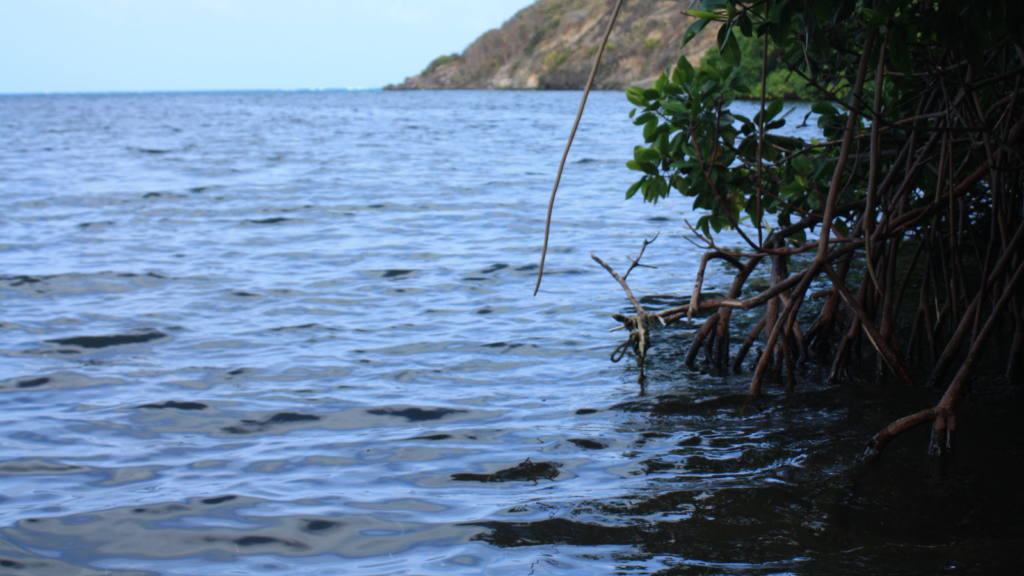Mangroves are floodable forests that extend along coasts, river mouths, and estuaries in tropical and intertropical zones of the planet. Their name comes from the abundance of mangrove trees: a shrub with thick leaves, gray, brown, and reddish stems, and large roots that protrude from the soil and water, forming an intricate network reminiscent of the legs of a giant spider.
These striking plants, which can reach up to 40 meters in height, have adapted to challenging environmental conditions, such as constant tidal changes, high water salinity, muddy soils poor in oxygen, strong winds, and high temperatures.
According to the most recent report from the Global Mangrove Alliance (GMA), there are approximately 14.7 million hectares of mangroves on the planet (about twice the surface area of Panama). A third of this figure is found in Southeast Asia, while North and Central America (including the Caribbean) host 15%, and South America 13.7%.
Mangroves are a crucial source of food, wood, fuel, and a long list of tangible and intangible services for millions living in their areas of influence. On a global scale, these benefits include supporting abundant biodiversity, capturing and storing large amounts of carbon, and regulating the impact of natural disasters.

Biodiversity nurseries
Due to their strategic location between land and sea, mangroves function as transition ecosystems on which more than 1,500 species depend in one way or another, according to figures from the United Nations Environment Programme.
As a result of the constant flow of saltwater from the ocean and, frequently, freshwater from rivers, mangrove sediment is rich in minerals and nutrients that sustain an extensive food chain.
The warm temperature, shade provided by shrubs, shallow water, and low predator pressure also contribute to mangroves being a habitat for the shelter and reproduction of marine creatures such as fish, oysters, crabs, and shrimp.
This abundant biodiversity is the basis of food security and the economy of numerous coastal communities. According to GMA figures, 4.1 million small and medium-sized fishers worldwide depend on mangroves.

Blue guardians
Mangrove forests cover less than 0.1% of the planet’s surface, but they can capture and store up to 10 times more carbon than terrestrial forests in their living biomass (leaves, stems, and roots) and in the soil.
Like other plant species, mangroves absorb carbon from the atmosphere for photosynthesis. Still, in their particular case, the soil flooding caused by tides makes the decomposition of dead material very slow, and carbon accumulates there for centuries or even millennia.
This unique ability has led mangroves to occupy an ever more prominent place in international climate action, where the importance of “blue carbon” (the one stored in mangroves, seagrasses, and salt marshes) is increasingly recognized.
In addition to being indispensable allies in the race towards a carbon-neutral world, mangroves act as a natural barrier that cushions the impact of hurricanes, storms, and other natural disasters. Although they cannot prevent these phenomena, mangroves reduce wave height and wind speed and retain debris and other objects that can cause human and economic losses.

Strong yet vulnerable
The current panorama of mangroves is worrying. The Food and Agriculture Organization of the United Nations (FAO) warns that, between 2000 and 2020, the planet suffered a net loss of 284,000 hectares of mangroves, while some 341 species of reptiles, amphibians, mammals, and fish from this habitat are threatened.
For its part, the Red List of the International Union for Conservation of Nature (IUCN) currently records 15 of the 70 known species of mangrove shrub with some significant degree of danger of extinction.
The main threats facing mangroves are the development of fish, shrimp, oil palm, and rice crops, infrastructure construction, and real estate development.
In addition, climate change also affects mangroves through increased temperature and sea level, increased CO2 in the atmosphere, and changes in precipitation. As if that weren’t enough, the area of mangroves lost to natural disasters has tripled in the last 20 years, and this trend is expected to continue worsening due to extreme weather, warns the FAO.
For all these reasons, the conservation, restoration, and sustainable use of mangroves are an urgent issue to achieve the climate goals of the Paris Agreement and their integration with the Global Biodiversity Framework, which will be one of the main objectives of COP16 that will take place at the end of October in Cali, Colombia.